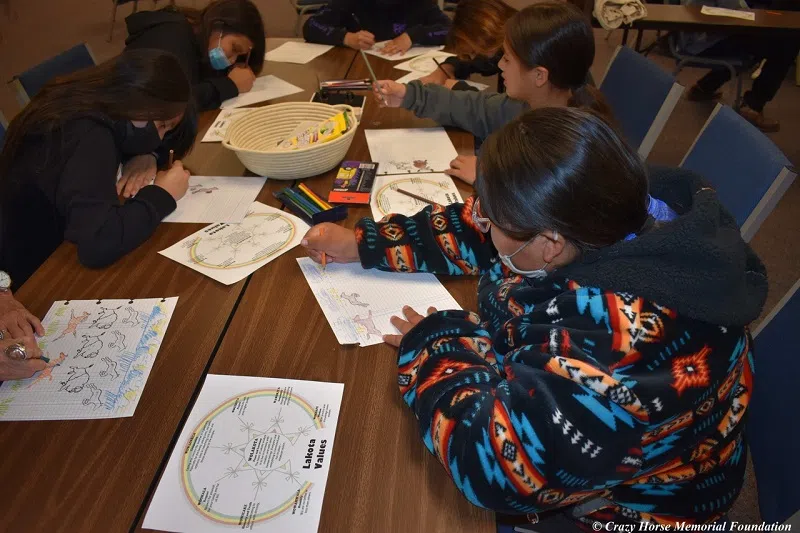Crazy Horse Memorial marked a significant milestone in May when it welcomed its first school group to view the Horn Chips Collection in The Indian Museum of North America. Thirty-six students and six teachers traveled from the Pine Ridge Reservation’s Batesland School on Friday, May 21 to learn more about Crazy Horse through the medicines a holy man made for the Lakota leader more than 150 years ago.
According to Andrew Dunehoo, museum curator and director of cultural affairs, the museum first learned about the Horn Chips Collection in 2014, when an anonymous private collector reached out to the Memorial. The Horn Chips family had entrusted these items to the collector, and when he had an opportunity to sell them internationally, he hesitated.
“He told us that something compelled him not to sell them, and to entrust them to us,” Dunehoo recounted. “We felt it important to organize cultural consultation for this collection, and we invited representatives of tribes from across the Oceti Sakowin, the Seven Council Fires. They believe these items are authentic. We held prayers and conducted a ceremony for them, because they are sacred.”
Lakota holy man Woptuha (Horn Chips) first began creating these medicines for Crazy Horse after the young Lakota man went on his hanbleceya, which literally translates to “crying for a vision.” Horn Chips interpreted Crazy Horse’s dreams and created appropriate medicines that would protect him. Over the years, Crazy Horse returned to Horn Chips for more medicines to provide guidance and renewed energies.
Although Crazy Horse often is called a chief, he did not hold that role in a traditional sense. He was a warrior, and as Dunehoo noted, he was deeply dedicated to his people.
“He was a servant leader,” Dunehoo explained. “Even as a young man, Crazy Horse embodied Lakota values. They were in his nature. He always put others ahead of himself.”
After Crazy Horse’s death in 1877, his medicines — now sacred relics — were passed down through the Horn Chips family, to the private collector, and finally to their forever home at Crazy Horse Memorial. Today, the Horn Chips Collection has a four-member advisory committee overseeing their care: Dennis Yellow Thunder, Eugene Black Crow, Waylon Black Crow, and Rick Gray Grass, all members of the Oglala Sioux Tribe.
“We work closely with them,” Dunehoo said. “They provide guidance on prayers and traditional beliefs, and they advise us on how to show proper respect for the items, including how we approach them, and even how we talk about them.”
The full Horn Chips Collection comprises 249 items; at present, approximately 15 are accessible to school groups through the Indian Museum of North America. Many of these are cut pieces of buffalo and mountain goat hide. They are simple, unembellished, and very fragile.
“Eventually we will have a dedicated, climate-controlled space for them to rest peacefully,” Dunehoo said. “For now, we are only making them available to school groups and other select groups in special circumstances, and we provide appropriate interpretation.
“Dennis Yellow Thunder has said that there is tremendous power and responsibility in these items that could change the world,” he continued. “They have the power to produce healing and positive energy. That has potential for all students, Native and non-Native.”
When Batesland School students arrived on May 21, staff members spoke with them about the importance of shedding all negative energies before approaching the sacred objects. Everyone rubbed sage to help detach those energies, taking advantage of the plant’s cleansing properties.
“This is an important cultural teaching,” Dunehoo said, “and the kids were just incredible. They were so respectful, kind, and reverent.”
The students then engaged with the unique Horn Chips Collection educational curriculum for grades 3-8, which was developed by Joe DeRouchey, Crazy Horse Memorial’s educational coordinator and assistant manager of visitor services. The curriculum incorporates Lakota language and stories, the significance of each item in teaching fundamental cultural principles, and opportunities for students to create their own winter count and ledger art.
“In the process, the kids learned that Crazy Horse was someone they should know and emulate,” Dunehoo said. “He was someone who stood up for a way of life, recognized the importance of the culture, and fought for its continuation.”
Crazy Horse Memorial encourages educators in grades 3-8 who are interested in the Horn Chips Collection to call (605) 673-4681 for more information and to make arrangements for a guided visit. Curricula for high school and post-secondary students and for elders are currently in development.

During their Horn Chips Collection experience, children from Batesland School created their own winter count and ledger art.
Photo credit Crazy Horse Memorial Foundation.

During their Horn Chips Collection experience, children from Batesland School created their own winter count and ledger art.
Photo credit Crazy Horse Memorial Foundation.







Comments